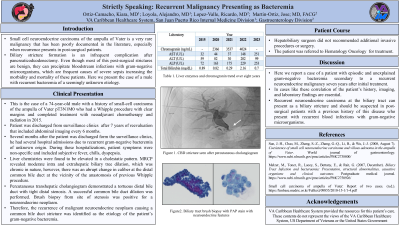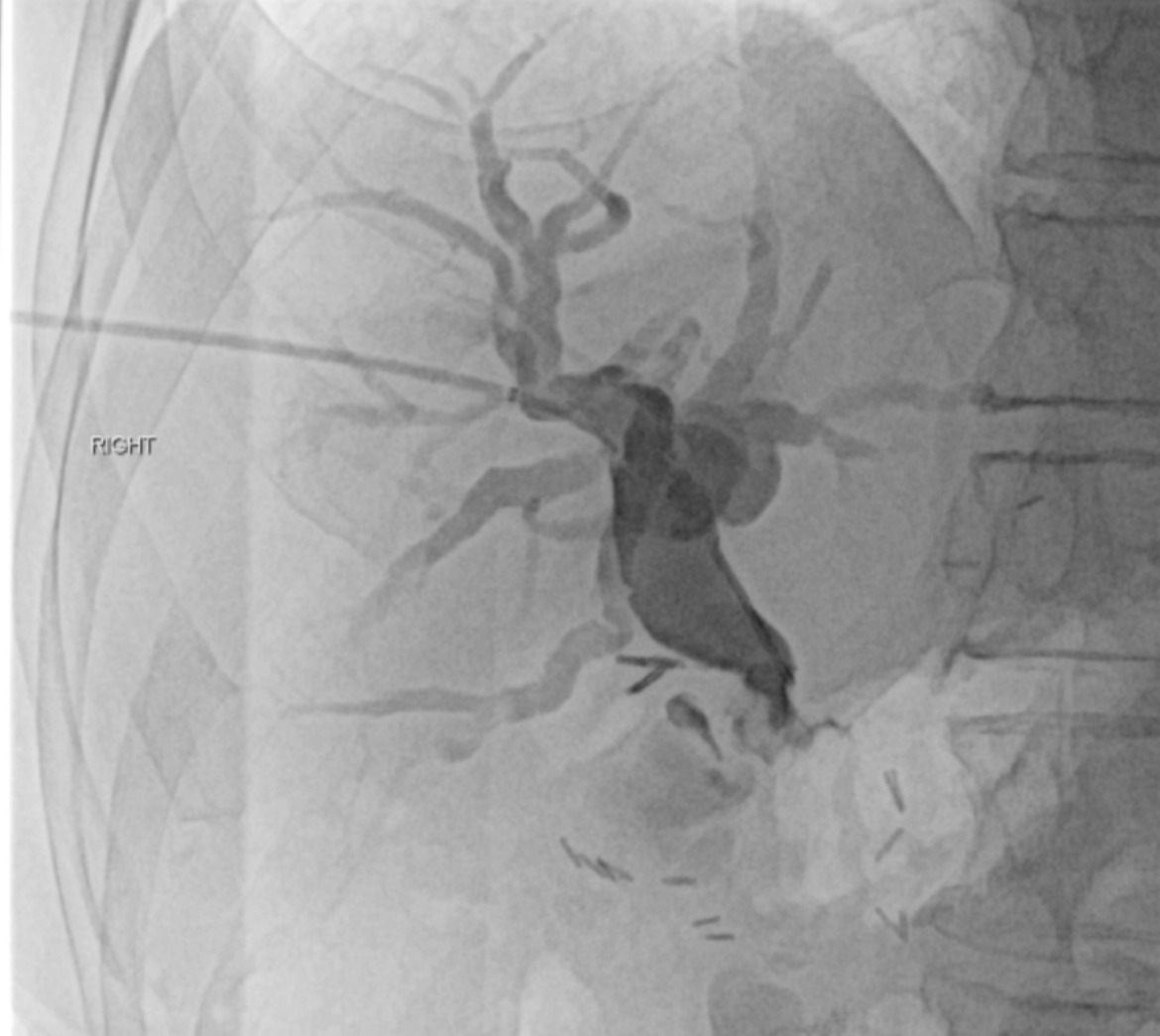Monday Poster Session
Category: Biliary/Pancreas
P1501 - Strictly Speaking: Recurrent Malignancy Presenting as Bacteremia
Monday, October 23, 2023
10:30 AM - 4:15 PM PT
Location: Exhibit Hall

Has Audio

Kiara C. Ortiz-Camacho, MD
VA Caribbean Healthcare System
San Juan, Puerto Rico
Presenting Author(s)
Kiara C.. Ortiz-Camacho, MD1, Alejandro J.. Loyola-Velez, MD2, Ricardo L.. López-Valle, MD1, José Martin-Ortiz, MD, FACG1
1VA Caribbean Healthcare System, San Juan, Puerto Rico; 2VA Caribbean Healthcare System, Isabela, Puerto Rico
Introduction: Small cell neuroendocrine carcinoma of the ampulla of Vater is a very rare malignancy that has been poorly documented in the literature, especially when recurrence presents in post-surgical patients. Biliary stricture formation is an infrequent complication after pancreaticoduodenectomy. Even though most strictures are benign, they can precipitate bloodstream infections with gram-negative microorganisms, which are frequent causes of severe sepsis increasing the morbidity and mortality of these patients. Here we present the case of a male with recurrent bacteremia of a seemingly unknown etiology.
Case Description/Methods: This is the case of a 74-year-old male with a history of small-cell carcinoma of the ampulla who had a Whipple procedure several years prior & that had presented with multiple hospital admissions due to recurrent gram-negative bacteremia of unknown origin. During these hospitalizations, patient symptoms were non-specific and included subjective fever, chills, dyspepsia. Liver chemistries were found to be elevated in a cholestatic pattern of injury. MRCP revealed moderate intra and extrahepatic biliary tree dilation, which was chronic in nature, however, there was an abrupt change in caliber at the distal common bile duct level at the vicinity of the anastomosis of previous Whipple procedure. Percutaneous transhepatic cholangiogram demonstrated a tortuous distal bile duct with tight distal stenosis. A successful common bile duct dilation was performed and a brush biopsy from site of stenosis was positive for a neuroendocrine neoplasm. Therefore, the recurrence of malignant neuroendocrine neoplasm causing a common bile duct stricture was identified as the etiology of the patient’s gram-negative bacteremia. The patient was ultimately drained after a cutaneous cholangiogram through biliary internal and external drainage.
Discussion: Here we report a case of recurrent bacteremia secondary to the reappearance of a neuroendocrine malignancy. In cases like these correlation of the patient’s history, imaging, and laboratory findings can diagnose malignancy-associated cholangitis in the absence of choledocholithiasis. Recurrent neuroendocrine carcinoma at the biliary tract can present as a biliary stricture and should be suspected in post-surgical patients with a previous history of this disease who present with recurrent blood infections with gram-negative microorganisms.

Disclosures:
Kiara C.. Ortiz-Camacho, MD1, Alejandro J.. Loyola-Velez, MD2, Ricardo L.. López-Valle, MD1, José Martin-Ortiz, MD, FACG1. P1501 - Strictly Speaking: Recurrent Malignancy Presenting as Bacteremia, ACG 2023 Annual Scientific Meeting Abstracts. Vancouver, BC, Canada: American College of Gastroenterology.
1VA Caribbean Healthcare System, San Juan, Puerto Rico; 2VA Caribbean Healthcare System, Isabela, Puerto Rico
Introduction: Small cell neuroendocrine carcinoma of the ampulla of Vater is a very rare malignancy that has been poorly documented in the literature, especially when recurrence presents in post-surgical patients. Biliary stricture formation is an infrequent complication after pancreaticoduodenectomy. Even though most strictures are benign, they can precipitate bloodstream infections with gram-negative microorganisms, which are frequent causes of severe sepsis increasing the morbidity and mortality of these patients. Here we present the case of a male with recurrent bacteremia of a seemingly unknown etiology.
Case Description/Methods: This is the case of a 74-year-old male with a history of small-cell carcinoma of the ampulla who had a Whipple procedure several years prior & that had presented with multiple hospital admissions due to recurrent gram-negative bacteremia of unknown origin. During these hospitalizations, patient symptoms were non-specific and included subjective fever, chills, dyspepsia. Liver chemistries were found to be elevated in a cholestatic pattern of injury. MRCP revealed moderate intra and extrahepatic biliary tree dilation, which was chronic in nature, however, there was an abrupt change in caliber at the distal common bile duct level at the vicinity of the anastomosis of previous Whipple procedure. Percutaneous transhepatic cholangiogram demonstrated a tortuous distal bile duct with tight distal stenosis. A successful common bile duct dilation was performed and a brush biopsy from site of stenosis was positive for a neuroendocrine neoplasm. Therefore, the recurrence of malignant neuroendocrine neoplasm causing a common bile duct stricture was identified as the etiology of the patient’s gram-negative bacteremia. The patient was ultimately drained after a cutaneous cholangiogram through biliary internal and external drainage.
Discussion: Here we report a case of recurrent bacteremia secondary to the reappearance of a neuroendocrine malignancy. In cases like these correlation of the patient’s history, imaging, and laboratory findings can diagnose malignancy-associated cholangitis in the absence of choledocholithiasis. Recurrent neuroendocrine carcinoma at the biliary tract can present as a biliary stricture and should be suspected in post-surgical patients with a previous history of this disease who present with recurrent blood infections with gram-negative microorganisms.

Figure: CBD Stricture Seen After Percutaneous Cholangiogram
Disclosures:
Kiara Ortiz-Camacho indicated no relevant financial relationships.
Alejandro Loyola-Velez indicated no relevant financial relationships.
Ricardo López-Valle indicated no relevant financial relationships.
José Martin-Ortiz indicated no relevant financial relationships.
Kiara C.. Ortiz-Camacho, MD1, Alejandro J.. Loyola-Velez, MD2, Ricardo L.. López-Valle, MD1, José Martin-Ortiz, MD, FACG1. P1501 - Strictly Speaking: Recurrent Malignancy Presenting as Bacteremia, ACG 2023 Annual Scientific Meeting Abstracts. Vancouver, BC, Canada: American College of Gastroenterology.
